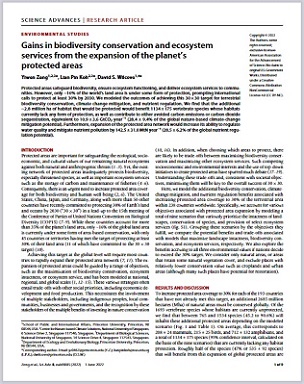
Protected areas safeguard biodiversity, ensure ecosystem functioning, and deliver ecosystem services to communities. However, only ~16% of the world’s land area is under some form of protection, prompting international calls to protect at least 30% by 2030. We modeled the outcomes of achieving this 30 × 30 target for terrestrial biodiversity conservation, climate change mitigation, and nutrient regulation. We find that the additional ~2.8 million ha of habitat that would be protected would benefit 1134 ± 175 vertebrate species whose habitats currently lack any form of protection, as well as contribute to either avoided carbon emissions or carbon dioxide sequestration, equivalent to 10.9 ± 3.6 GtCO2 year−1 (28.4 ± 9.4% of the global nature-based climate-change mitigation potential). Furthermore, expansion of the protected area network would increase its ability to regulate water quality and mitigate nutrient pollution by 142.5 ± 31.0 MtN year−1 (28.5 ± 6.2% of the global nutrient regulation potential).














